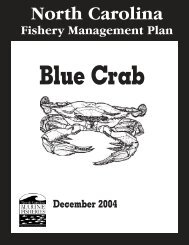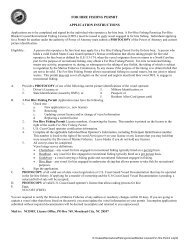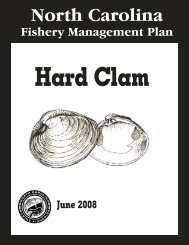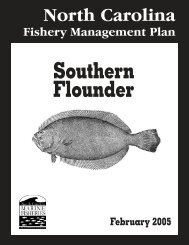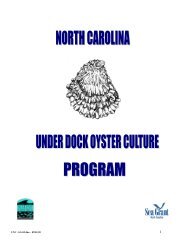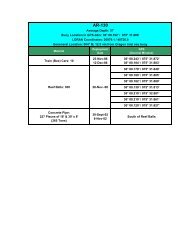Striped Mullet FMP - NC Dept. of Environment and Natural Resources
Striped Mullet FMP - NC Dept. of Environment and Natural Resources
Striped Mullet FMP - NC Dept. of Environment and Natural Resources
You also want an ePaper? Increase the reach of your titles
YUMPU automatically turns print PDFs into web optimized ePapers that Google loves.
6.1.9 Major gear types used in the fisherySeines <strong>and</strong> gill nets have been the two primary gear types involved in the fishery sincethe earliest documented l<strong>and</strong>ings in 1887. From 1887 to 1978, 60% <strong>of</strong> the total commercialharvest was l<strong>and</strong>ed by seines <strong>and</strong> 39% from gill nets (Figure 6.13). Gill net l<strong>and</strong>ings were largerthan seine l<strong>and</strong>ings in only five <strong>of</strong> 50 years <strong>of</strong> available l<strong>and</strong>ings data during this time period(Chestnut <strong>and</strong> Davis 1975; DMF unpublished data). The seine fishery dominated early l<strong>and</strong>ingsfrom 1887 to 1934, accounting for 61% <strong>of</strong> the total harvest (36% from gill nets). Total gill netl<strong>and</strong>ings exceeded seine l<strong>and</strong>ings (56% to 44%) for a short period, from 1937 to 1940. Seinesagain accounted for most <strong>of</strong> the fishery harvest (62% <strong>of</strong> total l<strong>and</strong>ings) from 1950 to 1978 (gillnets were responsible for 37% <strong>of</strong> total l<strong>and</strong>ings).100%90%Gill Nets Seine Other Gears80%% Total L<strong>and</strong>ings70%60%50%40%30%20%10%0%20021992198219721962195219421932192219121902189218821872YearFigure 6.13. Gear trends in the striped mullet fishery; proportion <strong>of</strong> total yearly l<strong>and</strong>ingsharvested by gill nets, seines, <strong>and</strong> other gears (Chestnut <strong>and</strong> Davis 1975; Bureau<strong>of</strong> Fisheries; DMF).Gill nets replaced seines as the dominant gear type in the fishery in 1979 (Figure 6.13).Its yearly proportion <strong>of</strong> the total fishery l<strong>and</strong>ings has steadily increased over the past 24 years.By 2001, 94% <strong>of</strong> total l<strong>and</strong>ings were harvested by gill nets, 4% from seines, <strong>and</strong> 1% from castnets.More detailed l<strong>and</strong>ings data with respect to fishing gears became available in 1994 dueto the creation <strong>of</strong> the <strong>NC</strong>TTP. The number <strong>of</strong> gears reported in the striped mullet fishery morethan doubled between the periods <strong>of</strong> 1972-1993 <strong>and</strong> 1994-2002, from 16 to 34 different geartypes. A maximum <strong>of</strong> three gears are recorded by <strong>NC</strong>TTP for each trip ticket <strong>of</strong> l<strong>and</strong>ings (since1994). However, <strong>NC</strong>TTP does not allocate harvest weight to each individual fishing gearreported on the trip ticket when multiple gears are listed. Therefore, unambiguous l<strong>and</strong>ingsfrom trip tickets with only one listed gear <strong>of</strong> harvest were used to proportionally allocate l<strong>and</strong>ings36




